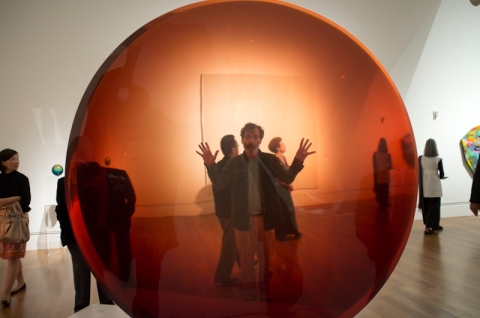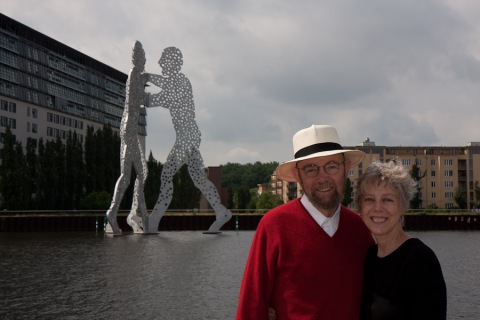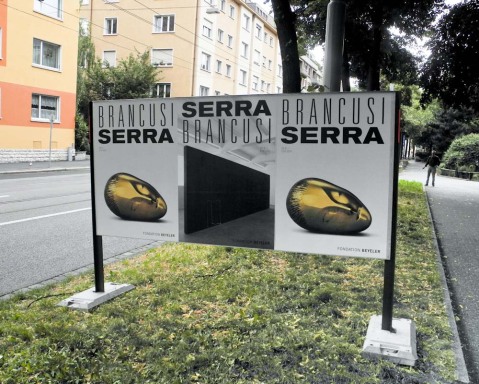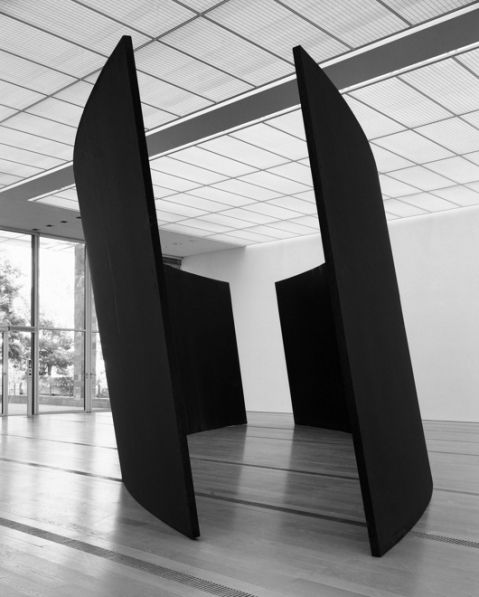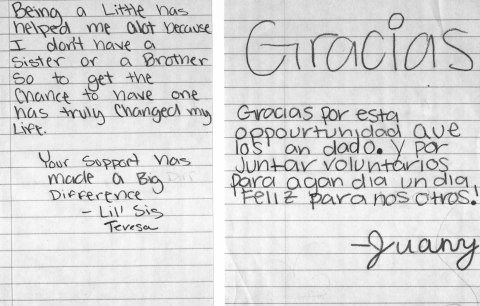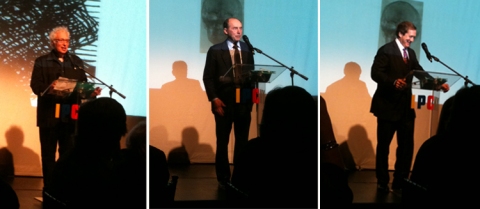Pacific Standard Time
October 5, 2011 § Leave a comment
October 5, 2011
The first weekend of October in Los Angeles was the official beginning of Pacific Standard Time, a six-month long collaboration of more than 60 cultural institutions across Southern California coming together for the first time, through a multitude of simultaneous exhibitions and programs, to tell the story of the Los Angeles art scene from 1945-1980. Collectors, museum professionals and art dealers from around the world traveled to LA, striving to get to as many of the VIP events, private collection tours and gallery receptions as they could. With over 70 galleries in Los Angeles and several in New York also participating, the Gemini workshop in Los Angeles and our gallery in New York each mounted complimentary exhibitions focusing on the works made during or inspired by the Pacific Standard Time era. These two exhibitions, titled Pacific Standard Editions, aspire to represent the time when the Gemini workshop and its artists burst onto the West Coast scene, making a rich and unique contribution to this burgeoning period in the history of art in Southern California.
On Saturday, October 1st, as a treat for special invited guests, Gemini opened the doors to its LA workshop and offered a glimpse of the tremendous effort that goes into edition-printing. Visitors watched as Master Printers editioned the enormous Serra Double Level II etching, Ed Ruscha’s colorful Liberty lithograph and Julie Mehretu’s 12-panel masterpiece Auguries. Notable among the many guests were Pacific Standard Time Chief Curator Andrew Perchuk, and former Gemini salesperson Lindsey Christensen, who returned to LA for the weekend festivities and to quickly visit the new Los Angeles art fair, Art Platform.
The following afternoon, Richard Tuttle landed at LAX, arriving on the new non-stop American Airlines flight from Santa Fe, carrying only a small canvas duffle. He came to town to check in on the ceramic project he is producing at Gemini and to sign the exquisite new etching that will be released this Fall. Sidney and I whisked Tuttle away to Maxfield, fashion central for Hollywood and the music business, so he could buy something for the Pacific Standard Time festivities at the Getty Museum that evening. With Tuttle dressed in a stunning new bright-green corduroy Balmain shirt, off the three of us headed to the hilltop Getty in Brentwood for the opening of Crosscurrents in L.A.: Painting and Sculpture, 1950-1970, where hundreds of LA artists, collectors, artworld luminaries and out-of-town visitors gathered at the gala reception.
Tuttle spent the following two days at Gemini, signing, numbering and hand-writing the title at the bottom of each impression of his new etching For John Altoon. To each impression he also added a curled pencil mark, unique to each sheet. The mark starts within the boundaries of the image, just above the signature, and, with drama and energy, spirals out to the margin of the paper. Tuttle also resolved the framing of his six new ceramic series, each of which is uniquely formed out of red earthenware clay. All are individually slip decorated, with the exception of the sixth series, which was finished with a yellow glaze. In three of the six “editions” – actually series of unique works – wires, copper and other materials are added to the surfaces.
On his last evening in Los Angeles, Tuttle accompanied Sidney and me to a conversation between John Baldessari and Christopher Knight, held in the Billy Wilder Theater at the Hammer Museum. We were also joined by Kalyn and Sidney’s assistant, Kate Guillen. Christopher Knight, Pulitzer Prize nominated journalist and long-time writer for the Los Angeles Times, began the evening by showing the promotional film created for Pacific Standard Time. The witty video features actor Jason Schwartzman being pursued by the voice and oversized head of Baldessari, who encourages Schwartzman not to be intimidated by fine art. It was a fun and engaging way to warm up the audience for the provocative and lively discussion that ensued. Knight began the conversation by asking Baldessari about his early days in National City, California, and Baldessari was very revealing in the personal and creative journey that after many years brought him the international acclaim that he enjoys today. He spoke of how he learned “more about painting from [ceramist] Peter Voulkos than anybody else,” and recalled meeting Paul Brach at University of California at San Diego in 1967. Two years later, Brach became the founding dean at Cal Arts, and recruited Baldessari to come teach at the school, where he met Nam June Paik, Alan Kaprow and many other artists whose work and careers impacted Baldessari. The evening was filled with informative dialogue on the mechanical process of Baldessari’s artmaking as well as the philosophical approach to the “what is art” question that artists ever since Duchamp have been exploring.
Rolling Out a Rosenquist
September 12, 2011 § Leave a comment
September 8, 2011
And now that we are up and running in Chelsea, our gallery drawers are once again filling up with proofs of the latest editions coming out of the Gemini G.E.L. workshop. One new arrival is James Rosenquist’s The Xenophobic Movie Director or Our Foreign Policy.
Rosenquist visited Los Angeles at the beginning of the year to escape New York’s dreary weather and begin his first collaboration with Gemini in over a decade. This past summer, the workshop had the pleasure of hosting the artist’s daughter (and current Rhode Island School of Design art student) Lily Rosenquist, for a brief printmaking internship, and in January, Master Printer James Reid was eager to begin collaborating with the elder Rosenquist.
The imagery in this new print references a 2004 painting of the same title measuring over 13 feet. Given the scale of this lithograph, 58” in length by 25″ high, several of the colored lithographic plates had to be split into more than one plate in order to facilitate consistent hand-printing. Rosenquist mixed each color ink to his exact specification, and this complex print was resolved with 18 runs through the press.
Always engaged with social and ecological issues, Rosenquist has paired iconic symbols of the American landscape with references to world affairs, reiterating his message by the hand-written title across the lower margin. Rosenquist’s printmaking continues to illuminate the artist’s highly-charged, deconstructive style and vibrant coloring with an airbrushed quality, derived from his experience as a billboard painter. This impressive lithograph made its public debut at Art Basel 42 and can be viewed in our gallery at 465 West 23rd Street.
On the Move!
September 6, 2011 § Leave a comment
September 6, 2011
With the arrival of the Fall season, it seems fitting to pause and reflect on what has transpired since our last entry many weeks ago. It was a time of transitions, of gains and losses, of happiness and excitement offset by bits of sadness. The summer has just ended with the passing of June Wayne, who helped pioneer a revival of fine-art printmaking when she founded the Tamarind Lithography Workshop in Los Angeles. Tamarind-trained printers and their descendants have found their way into many (if not most) of America’s workshops, certainly Gemini, so her passing on August 23rd sent a ripple through our industry as we lost one of its most important and influential members.
As I wrote of previously, summer began with a stop in Berlin prior to the days of the Basel Art Fair. I spent the daytime hours exploring Berlin’s exciting cultural scene or working the booth at the fair. Evenings, however, were a cacophony of late-night calls and emails between realtors, lawyers, bankers and accountants, all striving to negotiate a lease for our new gallery space on 24th Street. Yes, we’ve headed downtown to Chelsea, and by January 2012 we will be settled on the 3rd floor of a lovely old 6-story brick building at 535 West 24th Street. We can hardly wait! But much has happened – and is yet to happen – before we’re there.
Saying goodbye to our space at 980 Madison was surprisingly emotional and difficult. A gallery is more than just white walls and track lighting; for me, it has always been the embodiment of my philosophy of art dealing and the many friends and clients whose spirits become part of the space. Our nearly four years spent at 980 were an exciting step in the history of the gallery and will always hold a special significance.
As we packed up and moved out on June 30th, I thought of all the previous incarnations of the gallery and a flood of memories overcame me. I thought back to my arrival in New York in May of 1984 and the excitement of discovering the city as a new resident and a newly independent art dealer. I smiled at the thought of the miniscule elevator at the 55 Crosby Street loft that carried up my very first clients, followed by the space at 375 West Broadway that brought over 10 years of heartwarming and collegial collaboration with Betsy Senior. I remembered my reluctance to leave Soho which resulted in a very brief landing in the loft of printworld authority Karen McCready, who regrettably lost her battle with cancer just as I was conquering my own. I thought of the crazy small apartment at 58 West 58th Street that was meant to be only temporary and which unbelievably housed the “gallery” for nearly six years. I thought of all the help I received from colleagues, especially from Larry Gagosian and also Dan Rowen, the architect who calmly and expertly facilitated our move to 980 Madison. Ultimately, it was the memories of Dan that overcame me, for his premature death a year-and-a-half ago had hit me hard. He was talented, kind and generous, and I regularly felt his presence in the gallery, especially as I was leaving behind his creation.
But with endings come beginnings. The wooden print cabinets we swaddled in padded blankets for this move were first acquired for the Crosby Street loft, and will follow us to our new space on 24th Street. And happily, my dear friends and brilliant architects Peter Stamberg and Paul Aferiat will finally build the gallery we’ve made conceptually more than a few times over the years. This current move would be impossible without the generosity, once again, of artworld colleagues – this time in particular Paula Cooper, whose 23rd Street former space we now have the honor of occupying until construction on our 24th Street gallery is completed in late December. And throughout my gallery’s 27 years, it all would have been impossible without the love and support of friends and family, especially my husband Sidney; the artists whose extraordinary works have filled those print cabinets and adorned our walls; and my incredible staff, present and past, whose enthusiasm, talent and commitment to the gallery have inspired me more than words can express.
Tuttle tries his hand at clay
June 29, 2011 § Leave a comment
June 29, 2011
After a successful etching collaboration in 2009, Gemini welcomed Richard Tuttle’s return to the Los Angeles workshop this month with open arms. Inspired to study the dynamics of clay in Southern California, Tuttle was interested in fabricating editioned tiles. The project, and Tuttle himself, was certainly influenced by the work of Peter Voulkos and Ken Price, founder and student of the ceramics department at Otis College, respectively. Also an inspiration to Tuttle was Sidney, as he spent years laboring over a potter’s wheel in night school and was a classmate of Elsa Rady’s at Chouinard Art Institute, now known as Cal Arts. Much of the important and vibrant history of clay in Los Angeles will be explored as part of the Getty Center’s Pacific Standard Time, at an exhibition called Clay’s Tectonic Shift at Scripps College opening in early January 2012.
During Tuttle’s visit to Los Angeles, celebrated photographer and LA native Jim McHugh stopped by the workshop and conversed with the artist while snapping a few portraits, and Tuttle also met with Print Curator Louis Marchesano while exploring the exhibition, Luminous Paper: British Watercolors and Drawings, at the Getty Museum. Understandably, Tuttle was intent on seeing this terrific show, as watercolor is regarded as one of the most challenging artistic techniques and certainly one that Tuttle has tackled in his unique works. Its liquid nature is capable of extraordinary effects of luminosity, but is often challenging for an artist to control. The exhibition presents works of the 1700s and 1800s by some of the greatest British masters of the medium, including Thomas Gainsborough, J.M.W. Turner, and William Blake, as well as an installation of three Yorkshire countryside watercolors by contemporary British artist David Hockney, bringing the tradition of the watercolor into the present day.
Tuttle’s clay project at Gemini should be resolved shortly and will likely consist of six series of tiles, each with black slip glazing, hand painted by the artist. It is with great anticipation that we look forward to presenting this work in New York later this year.
Dorothy said it best
June 21, 2011 § Leave a comment
June 21, 2011
There is no place like home. We have just touched down in Los Angeles after 3 exhausting but thrilling weeks in Europe. Skipping the madness of the opening days of the Venice Biennale, Sidney and I, accompanied by our daughter, the much-admired jewelry designer Suzanne Felsen, and her long-time companion Kevin Swanson, instead began our trip in Berlin. We were eager to explore the city’s extraordinary art and architecture and take in a few fabulous meals, following the recommendations of some dear friends.
One of our first activities was to meet up with art collectors Hilde and Busso Bartels, Berlin natives who were able to help us prioritize the many things to see by giving us an extensive driving tour throughout the city. They also introduced us to the extraordinary library at Humboldt University, designed by architect Max Dudler. Low-key on the outside and eye-popping on the inside, it is something that we certainly would have missed without their introduction.
We visited lots of museums, including a stop at the Berggruen Museum, repository of the magnificent collection of Heinz Berggruen, legendary art dealer and father of San Francisco galleriest John Berggruen. While there, we had the good fortune to encounter Olivier Berggruen, the youngest of the Berggruen sons, who took us into a private office to share with us his latest acquisition, an astonishingly fully-rendered Picasso sketchbook.
Beyond the memorable artworks we were privileged to view in the many museums and galleries we visited, we found a number of works by Gemini artists throughout the city. On our daily walk to coffee, we’d see Richard Serra’s Line of the Curve prints in the Westin Hotel, and we made an excursion with a cooperative taxi-driver to the Jonathan Borofsky Molecule Man sculpture in the Spree river (photo). We attended a reception for Andrea Zittel, with whom Gemini has been discussing a project, and saw her fantastic Pattern of Habit exhibition at Spruth Magers. We also attended the opening for Bruce Nauman’s For Children/For Beginners exhibition at the Konrad Fischer Galerie, and unexpectedly found the artist in attendance! It was a wonderful surprise to spend some time with Bruce. After the opening, we wandered around the corner to the lively artworld restaurant Sale e Tabacchi which Gemini artist Julie Mehretu had introduced us to two years ago while she was living in Berlin to complete her Goldman Sachs mural.
Reluctantly, we eventually had to leave Berlin behind, but fortunately our next stop was Switzerland, with its familiar cities, restaurants and routine activities. We landed in Basel on a Friday night, just in time for our first of several dinners at Chez Donati, the artworld darling during Art Basel, and arrived at the convention center the following morning in our blue jeans and tennis shoes, fortified and ready for the labors of installing the Gemini booth. We made enormous progress on our first day, so we felt relaxed on Sunday as we headed to Zurich in order to attend the annual reception for new paintings by John Baldessari at Mai 36 Galerie. In this exhibition, titled Double Vision, Baldessari couples iconic images by great artists such as Cezanne, Lewitt, Matisse and Warhol with the printed name of another artist, written out in his classic formal type. This deliberate false attribution is a classic Baldessari tongue-and-cheek puzzle on art history. He also removes iconic motifs from their traditional context, subjecting them to radical intervention and placing them in an unusual perspective. In all, Baldessari effectively has altered the images’ historical recognition and familiar meaning, while still allowing viewers to identify formal similarities between the originals and his versions.
Back to work on Monday, we completed our efforts in setting up the booth and were ready as the doors to Art Basel opened to enormous crowds on Tuesday. Amongst the many opening day visitors to the Gemini booth was British Museum curator Stephen Coppel, collectors Margrit and Paul Hahnloser and, relaxed and happy with his Zurich exhibition, Baldessari.
Brancusi and Serra, together at Fondation Beyeler
June 18, 2011 § Leave a comment
Last night, Sidney and I attended the reception that the Beyeler Museum hosts annually for the gallery exhibitors and VIP visitors to Art | Basel. The light rainfall couldn’t dampen the attendance of the crowd nor its reaction to the stunning exhibition of sculptures by Constantin Brancus and Richard Serra. There were numerous works by both artists that I and many other viewers had never seen before. Multiple variants of Brancusi’s “Kiss” surprised us, and a magnificent room of Serra’s enormous Paintstik “Weights and Levels” drawings warmed our hearts, as we had related prints hanging in our booth at the fair.
Serra became familiar with the sculptures of Brancusi while living in Paris on a Yale Traveling Fellowship, and was deeply moved. Serra returned to New York and a few years later presented his own work in three dimensions – pieces of molten lead splashed into junctures between floor and wall – in his first exhibition at Leo Castelli Warehouse. Decades later, Serra’s sculptures and drawings have traveled to Basel, Switzerland, to converse with the legacy of Brancusi at the Fondation Beyeler.
The exhibition selects 40 breathtakingly elegant works by Brancusi that amount to nearly a retrospective of their own, showing the artist’s career as a cornerstone of the birth of abstraction through a mastery of various materials and presence in space. Ten sculptures by Serra, ranging from an early piece in rubber to his characteristic steel curves, reveal how the artist once deeply inspired by Brancusi has succeeded in creating his own handbook of possibilities.
Serra was unable to return to Basel for this reception, however after overcoming the tremendous challenge of guiding the installation of seventy tons of steel, he sat down for a conversation with Martin Schwander, and it is available on VernissageTV (Artist Talk with Richard Serra at Fondation Beyeler). While explaining how he came to work in three dimensions, Serra commented that it was the only way “to be the subject of the experience of something in space.” He also told of his coming into possession of a massive quantity of rubber, thanks to a local store going out of business, and admitted to writing down a long verb list of activities to do with all the material sitting in his workspace. As a result, Serra’s expansive oeuvre has shattered the vocabulary of sculpture.
The exhibition is on view in Basel through August 21st. If you don’t have the opportunity to visit the exhibition in person, you can take a virtual tour: Constantin Brancusi and Richard Serra.
Gemini Artists Exhibiting in Europe
June 10, 2011 § Leave a comment
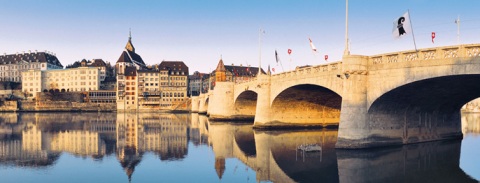 If you find yourself at Art Basel or if your summer plans include travel to Europe, below are a few gallery and museum exhibitions featuring Gemini artists to consider:
If you find yourself at Art Basel or if your summer plans include travel to Europe, below are a few gallery and museum exhibitions featuring Gemini artists to consider:
GERMANY
Bruce Nauman: Für Kinder / Beschriebene Kombinationen
Konrad Fischer Galerie – Berlin, Germany
9 June – 30 July 2011
ITALY
Julie Mehretu: In Praise of Doubt
Di Palazzo Grassi – Punta Della Dogana, Venice
9 April 2011 – 31 December 2012
Larry Bell, Vija Celmins, Ed Kienholz, Kenneth Price, Ed Ruscha, and James Turrell
Venice in Venice, Glow & Reflection – Venice California Art from 1960
4 June – 31 July 2011
SWITZERLAND
John Baldessari, Daniel Buren, Dan Flavin, and Robert Rauschenberg
Art Unlimited, Art Basel
Richard Serra: Constantin Brancusi & Richard Serra
Fondation Beyeler, Switzerland
22 May – 21 August 2011
John Baldessari: Your Name in Lights
Stedelijk Museum and Holland Festival, Amsterdam
1 – 26 June 2011
The Art of Saying Thank You
May 21, 2011 § Leave a comment
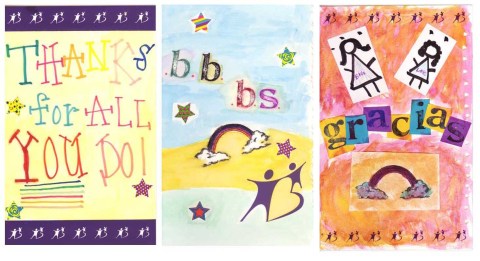 Handmade cards by Bigs and Littles
Handmade cards by Bigs and Littles
May 21, 2011
The Gemini workshop opened its doors on a Saturday afternoon to nine “Littles” from Big Brothers Big Sisters, an agency that matches mentors with at-risk youth in Los Angeles. The Littles, ranging from 9 to 14 years old and accompanied by their Big Brother or Big Sister, learned to make screenprints and were taught creative ways of expressing appreciation during a workshop titled “The Art of Saying Thank You.” The workshop was led by Joni (who has been a BBBS Board member since 1995), Gemini Master Printer Jim Reid and Mindy L. Zasloff, President of the human resources consulting firm, People Skills Are An Art.
The Bigs and Littles took a quick tour of the workshop before getting down to business with Jim Reid in the screenprinting shop. As each person stepped up to the press to pull a couple impression from a screen, the group cheerfully applauded each successful print pulled. Mindy then guided the Bigs and Littles through the process of writing a thoughtful note expressing thanks or what it means to have been matched. Once the screenprints were cut down to the size of a folded note-card, the Bigs and Littles embellished them with watercoloring, rubber-stamped images, bits of colored construction paper and colorful stickers. The day was a resounding success – the matches had an exceptionally fun day, and the cards produced will be used for expressing gratitude to the agency’s major donors.
IPCNY Spring Benefit, 2011
May 19, 2011 § Leave a comment
May 19, 2011
On Thursday, our gallery staff members Chris and Jae-Min attended the International Print Center New York’s (IPCNY) 2011 Spring Benefit.
The evening began with a pre-reception event at the IPCNY’s gallery space to view their current exhibition, Artists Collect: Prints from the Collection of Sol LeWitt, Kiki Smith, Philip Taaffe, Richard Tuttle, and was followed by cocktails and dinner at Cedar Lake. This year, the IPCNY honored artist Terry Winters, ULAE publisher Bill Goldston, and collector Jordan Schnitzer for their enormous contributions and achievements in the print world. It was a cheerful and celebratory evening with Christopher Gaillard as Master of Ceremonies, and Lisa Phillips, Christophe Cherix, and Joseph Goddu as presenters. There was also no shortage of notable attendees such as artist Vija Celmins, Chelsea gallerists Larry Shopmaker and Betsy Senior, Jim Kempner and Dru Arstark, and Mary Ryan, plus respected art advisors Janice Oresman and Sharon Coplan Hurowitz, and IFPDA Executive Director, Michele Senecal.
The first and only non-profit institution devoted solely to the exhibition and understanding of fine art prints, we congratulate the IPCNY on their 10th anniversary!
Doctor Baldessari, I presume!
May 14, 2011 § Leave a comment
May 14, 2011
On a lovely Saturday afternoon in San Francisco, John Baldessari received an honorary Doctorate from the California College of the Arts. Along with fellow Doctoral recipient Betty Reid Soskin, Baldessari was applauded by the hundreds in attendance at the graduation ceremony held at the Concourse Exhibition Center near the CCA San Francisco campus. Founded in 1907, CCA is one of the most respected schools teaching fine art, architecture, design and arts management to undergraduate and graduate students. Prior notable recipients of honorary Doctorates at CCA include Gemini artists Josef Albers, Frank Gehry, Ann Hamilton, Isamu Noguchi, Claes Oldenburg, Ed Ruscha, Richard Serra, Wayne Thiebaud, James Turrell and Richard Tuttle
Flying from New York on the third leg of our 10-day trip that had begun in Chicago, Sidney and I landed in time to dine on Friday night with John and gallerists Gretchen and John Berggruen. At Saturday’s ceremonies, CCA President Stephen Beal spoke of Baldessari’s considerable influence on students, particularly those at CCA, and of Baldessari’s years of dedication to the teaching and making of art. John, with his typical humility and humor, gave simple words of advice to the graduating students, slyly referencing his own many years of hard work and slowly-gained, eventual success. In closing, he quoted the words of wisdom imparted by an old Japanese surfer he once met in Hawaii: “Paddle, paddle, paddle. Some day big wave come.”

